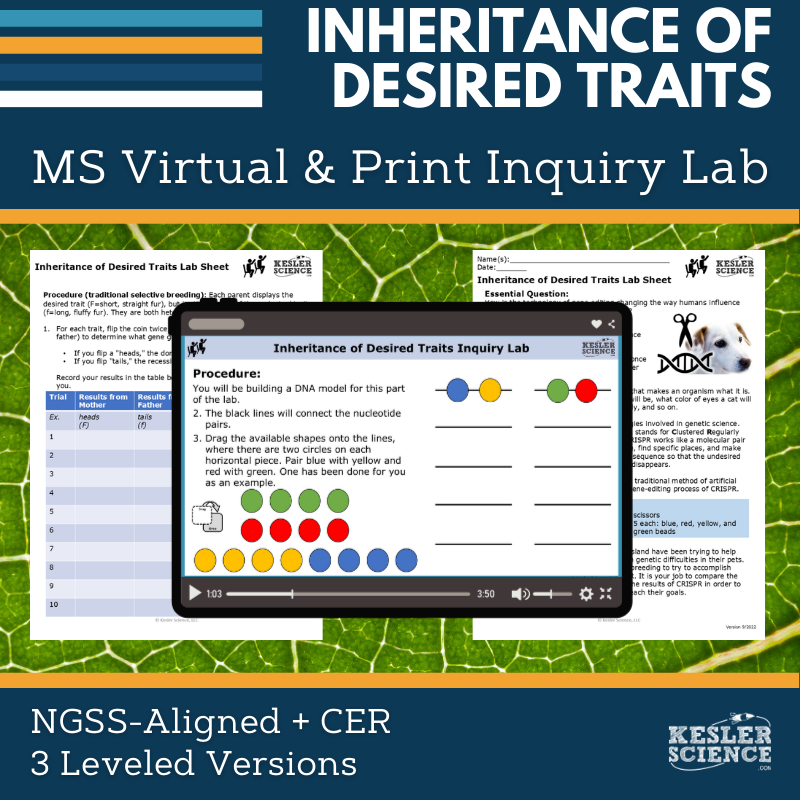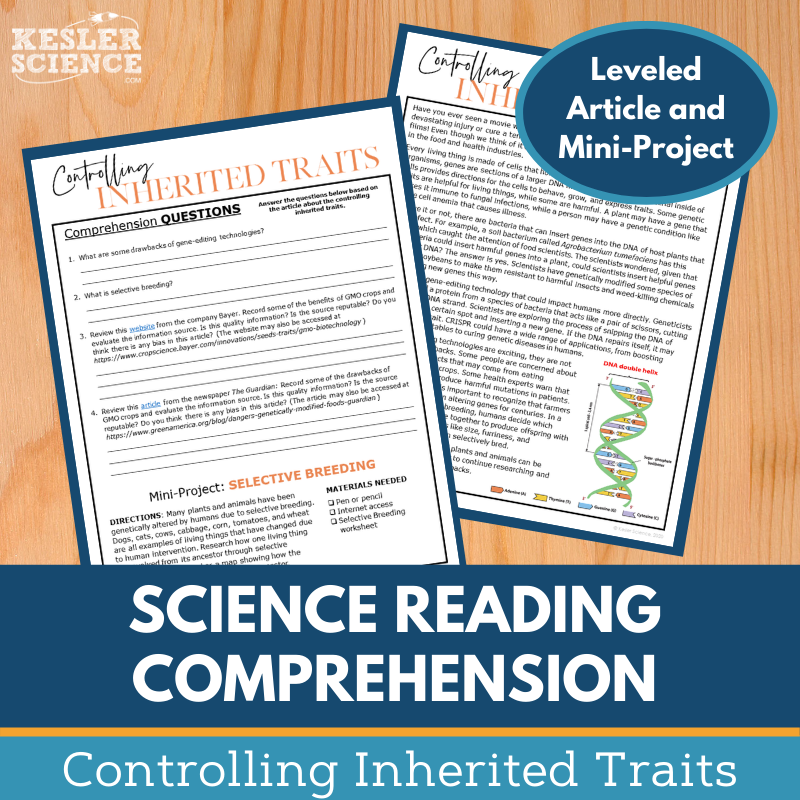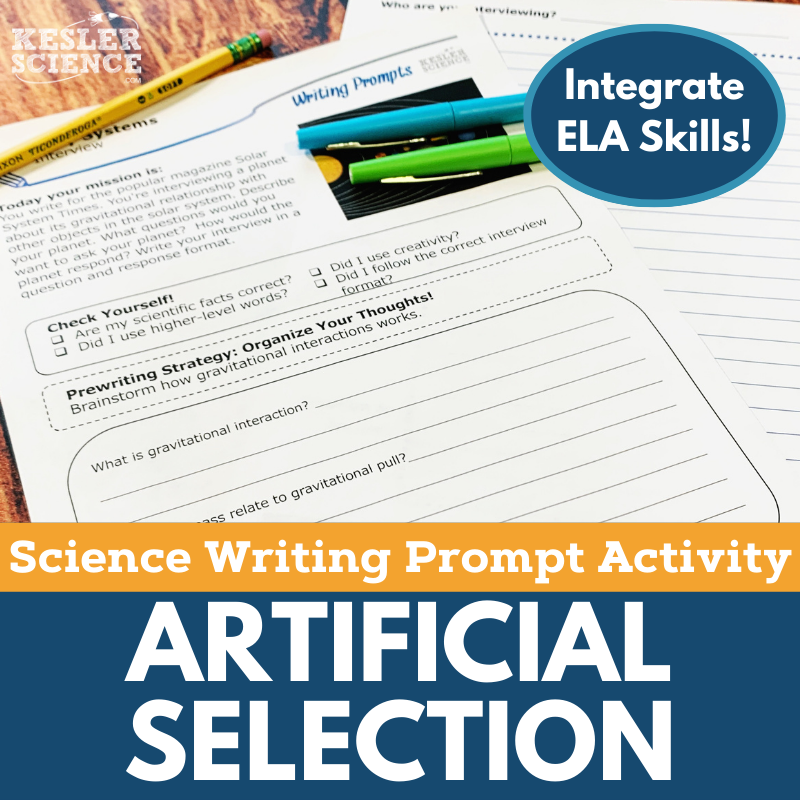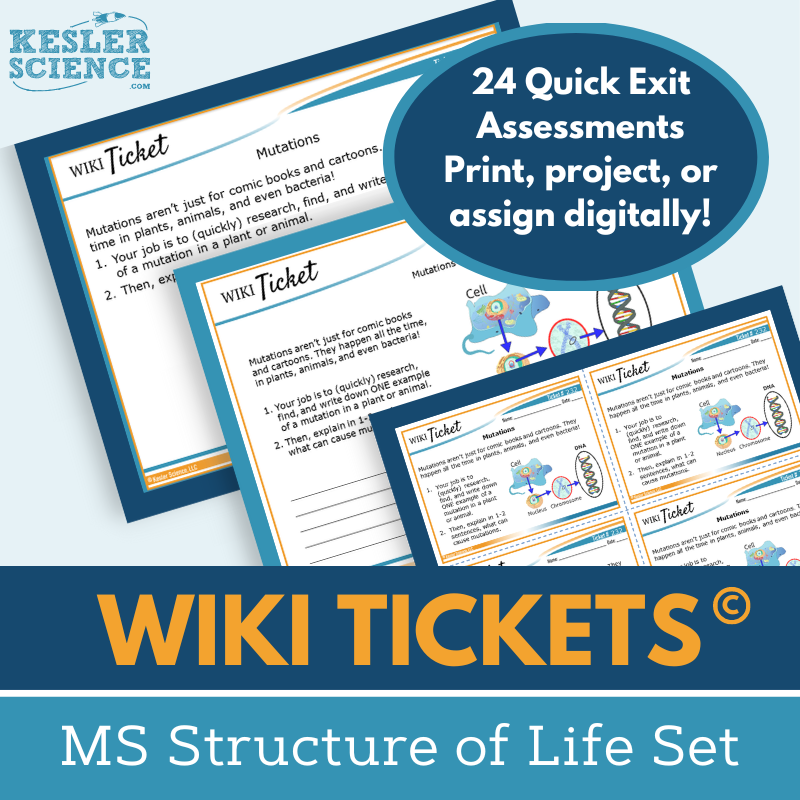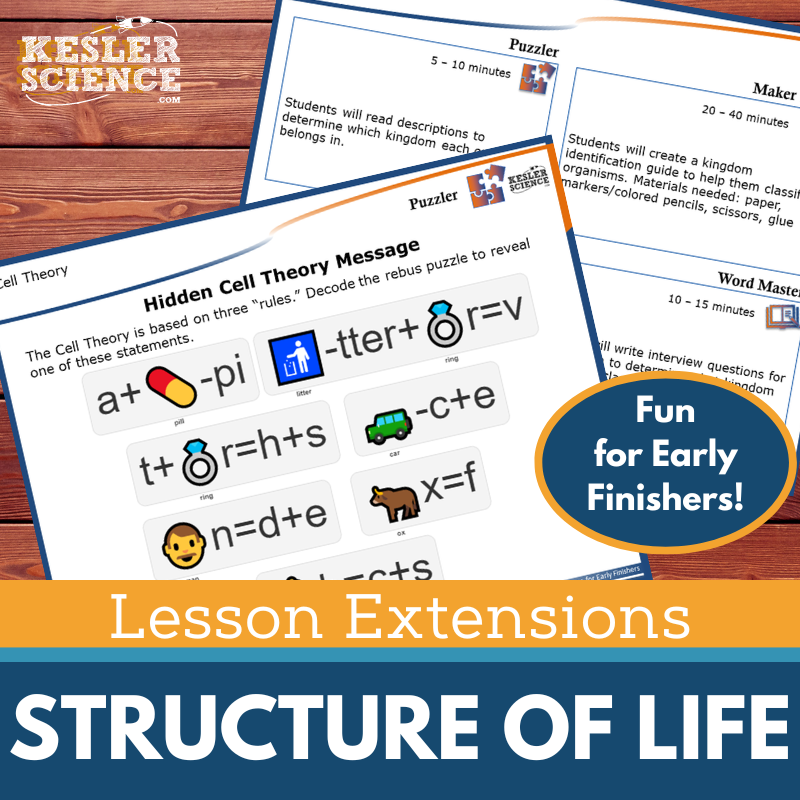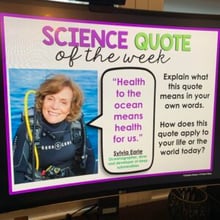Inheritance of Desired Traits Activities for Middle School Science
Students explore how gene editing and artificial selection impact inherited traits with this engaging resource aligned to NGSS MS-LS4-5. The resources below will give students a comprehensive understanding of inheritance of desired traits. All of the following materials are also included in the Kesler Science Membership.
The Inheritance of Desired Traits Inquiry Lab aligns with NGSS MS-LS4-5, helping students explore how gene editing technology influences inherited traits. This lab offers both digital and hands-on formats, allowing students to engage in an interactive simulation or a printed experiment. Both versions include comprehension questions, Claim-Evidence-Reasoning (C.E.R.) prompts, and a reflection section.
Differentiation is built in with three levels: dependent for on-level learners, modified for structured support, and independent for advanced students. The hands-on version requires simple materials like pipe cleaners and beads, while the digital format is fully interactive with no materials needed. Editable PowerPoint files ensure compatibility with Google Slides, and teacher resource pages provide standards, objectives, preparation guidance, and answer keys.
The Inheritance of Desired Traits Inquiry Lab aligns with NGSS MS-LS4-5, helping students explore how gene editing technology influences inherited traits. This lab offers both digital and hands-on formats, allowing students to engage in an interactive simulation or a printed experiment. Both versions include comprehension questions, Claim-Evidence-Reasoning (C.E.R.) prompts, and a reflection section.
Differentiation is built in with three levels: dependent for on-level learners, modified for structured support, and independent for advanced students. The hands-on version requires simple materials like pipe cleaners and beads, while the digital format is fully interactive with no materials needed. Editable PowerPoint files ensure compatibility with Google Slides, and teacher resource pages provide standards, objectives, preparation guidance, and answer keys.
This Controlling Inherited Traits Science Reading Comprehension Lesson explores how technology has influenced the inheritance of desired traits in organisms. Students read a nonfiction article on controlling inherited traits, answer comprehension questions, and research how a living organism has evolved through selective breeding.
Designed for middle school students, the resource includes two leveled science passages (Lexile 1100-1300), five to seven comprehension questions, a hands-on mini-project, and a Cornell notes template. The article encourages critical thinking, discussion, and science literacy.
Ideal for sub plans, ISS, extra credit, or whole-class instruction, this resource supports both in-person and virtual learning. It is compatible with Google Classroom, MS Teams, Schoology, and Canvas, allowing students to complete assignments digitally.
This Controlling Inherited Traits Science Reading Comprehension Lesson explores how technology has influenced the inheritance of desired traits in organisms. Students read a nonfiction article on controlling inherited traits, answer comprehension questions, and research how a living organism has evolved through selective breeding.
Designed for middle school students, the resource includes two leveled science passages (Lexile 1100-1300), five to seven comprehension questions, a hands-on mini-project, and a Cornell notes template. The article encourages critical thinking, discussion, and science literacy.
Ideal for sub plans, ISS, extra credit, or whole-class instruction, this resource supports both in-person and virtual learning. It is compatible with Google Classroom, MS Teams, Schoology, and Canvas, allowing students to complete assignments digitally.
The Artificial Selection Science Writing Prompt Activity engages middle school students in a creative letter-writing exercise to reinforce their understanding of artificial selection. Aligned with MS-LS4-5, this student-centered activity allows learners to gather and synthesize information about technologies that influence the inheritance of traits in organisms. Designed for both in-person and virtual learning, it fosters science reasoning and writing skills.
This resource includes teacher directions with an answer guide, project ideas, and rubrics, along with projection and print-friendly handouts in both full-sized and half-sheet formats. A digital interactive version is also available in PowerPoint and Google Slides. Ideal for cross-curricular activities, pre-test assessments, student choice projects, early finisher tasks, extra credit, make-up work, and TELPAS samples, this writing prompt encourages creativity and engagement while reinforcing key science concepts.
The Artificial Selection Science Writing Prompt Activity engages middle school students in a creative letter-writing exercise to reinforce their understanding of artificial selection. Aligned with MS-LS4-5, this student-centered activity allows learners to gather and synthesize information about technologies that influence the inheritance of traits in organisms. Designed for both in-person and virtual learning, it fosters science reasoning and writing skills.
This resource includes teacher directions with an answer guide, project ideas, and rubrics, along with projection and print-friendly handouts in both full-sized and half-sheet formats. A digital interactive version is also available in PowerPoint and Google Slides. Ideal for cross-curricular activities, pre-test assessments, student choice projects, early finisher tasks, extra credit, make-up work, and TELPAS samples, this writing prompt encourages creativity and engagement while reinforcing key science concepts.
The WIKI Tickets© Structure of Life Set offers 24 formative assessments designed for 6th-8th grade science, providing flexible and engaging ways to check student understanding. Each topic is available in five formats: a full-screen projection version, three printable handout sizes, and an interactive digital version compatible with PowerPoint and Google Slides.
Aligned with NGSS and TEKS standards, these assessments cover essential life science topics such as cell function, CRISPR, environmental genetic factors, heredity, reproduction, levels of cellular organization, and genetic mutations. A bonus table of contents file is included to show standard alignment. These WIKI Tickets© can be used for in-person or virtual learning, making them versatile for any classroom setting. Students can respond on paper, digitally, or in a remote 1:1 environment. Use them as exit tickets, bellringers, or quick checks to assess student progress effectively.
The WIKI Tickets© Structure of Life Set offers 24 formative assessments designed for 6th-8th grade science, providing flexible and engaging ways to check student understanding. Each topic is available in five formats: a full-screen projection version, three printable handout sizes, and an interactive digital version compatible with PowerPoint and Google Slides.
Aligned with NGSS and TEKS standards, these assessments cover essential life science topics such as cell function, CRISPR, environmental genetic factors, heredity, reproduction, levels of cellular organization, and genetic mutations. A bonus table of contents file is included to show standard alignment. These WIKI Tickets© can be used for in-person or virtual learning, making them versatile for any classroom setting. Students can respond on paper, digitally, or in a remote 1:1 environment. Use them as exit tickets, bellringers, or quick checks to assess student progress effectively.
Lesson Extensions provide engaging, student-choice activities designed to challenge early finishers and deepen their understanding of life science concepts. These activities help reinforce critical thinking, creativity, and problem-solving while keeping students engaged with rigorous yet enjoyable learning opportunities. They are ideal for lesson wrap-ups, independent challenges, and filling downtime during testing.
Each extension includes four interactive components: Puzzler for problem-solving, Maker Space for hands-on STEAM activities, Tech Connection for digital demonstrations, and Word Master for creative writing. With teacher directions, answer keys, and both print and projection versions, these extensions support flexible learning and enrichment.
Covering topics such as artificial selection, body systems, cell functions, genetic variations, heredity, and natural selection, Lesson Extensions align with NGSS and TEKS science standards, ensuring meaningful connections to curriculum goals.
Lesson Extensions provide engaging, student-choice activities designed to challenge early finishers and deepen their understanding of life science concepts. These activities help reinforce critical thinking, creativity, and problem-solving while keeping students engaged with rigorous yet enjoyable learning opportunities. They are ideal for lesson wrap-ups, independent challenges, and filling downtime during testing.
Each extension includes four interactive components: Puzzler for problem-solving, Maker Space for hands-on STEAM activities, Tech Connection for digital demonstrations, and Word Master for creative writing. With teacher directions, answer keys, and both print and projection versions, these extensions support flexible learning and enrichment.
Covering topics such as artificial selection, body systems, cell functions, genetic variations, heredity, and natural selection, Lesson Extensions align with NGSS and TEKS science standards, ensuring meaningful connections to curriculum goals.
This Amazing Anchors Phenomenon Lesson introduces artificial selection through real-world connections. It begins with an introductory reading on optogenetics and gene therapy, followed by comprehension and extension questions to deepen understanding. An explanatory reading further explores the science behind gene therapy and artificial selection, with additional reinforcement questions to support learning.
Aligned with NGSS standard MS LS4-5, this no-prep resource includes teacher directions, answer keys, projection slides, and editable materials in both print and digital formats for Google Classroom and other LMS platforms. A differentiated version provides sentence starters for student support. Designed to bookend a lesson, these engaging readings serve as supplements to reinforce learning in any in-person or virtual classroom.
This Amazing Anchors Phenomenon Lesson introduces artificial selection through real-world connections. It begins with an introductory reading on optogenetics and gene therapy, followed by comprehension and extension questions to deepen understanding. An explanatory reading further explores the science behind gene therapy and artificial selection, with additional reinforcement questions to support learning.
Aligned with NGSS standard MS LS4-5, this no-prep resource includes teacher directions, answer keys, projection slides, and editable materials in both print and digital formats for Google Classroom and other LMS platforms. A differentiated version provides sentence starters for student support. Designed to bookend a lesson, these engaging readings serve as supplements to reinforce learning in any in-person or virtual classroom.
Year-Round Resources
These year-round activities will increase your students' understanding of many middle school science topics. All of these activities are also included in the Kesler Science Membership.
Visual Data & Graphing
You're not alone if your students struggle with understanding graphs, charts, and tables. It's a skill that takes an enormous amount of practice. This resource will help students build a strong foundation in analyzing data and creating their own data visualizations.
Bell Ringers and Warm-Ups
These middle school science bell ringers are an excellent way to engage your students as soon as they walk into your classroom. This comprehensive FULL YEAR resource includes everything you need to start off each science class with an interesting warm-up activity.
Review Board Games
Each game board has been carefully designed to keep students engaged. There are 10 different action spaces on each board and dozens of question cards. All of the actions are related to science concepts and keep the students motivated throughout the game.
Each game is ready to play. Simply print out the board and the cards and let the students enjoy reviewing nine different units.
Essential Questions and Standards
Below are the essential questions and standards associated with the lessons and activities included in the inheritance of desired traits unit. This topic is only one of more than 100 middle school science topics included in the Kesler Science Membership.
-
How is the technology of gene editing changing the way humans influence the genetic traits passed on by organisms?
-
NGSS - MS-LS4-5 Inheritance of Desired Traits
Kesler Science Membership
Imagine never having to search for another middle school science lesson again. The membership gives you access to ALL of the Kesler Science products in one place (Yes, including everything above).
Say goodbye to long hours of lesson prep.

